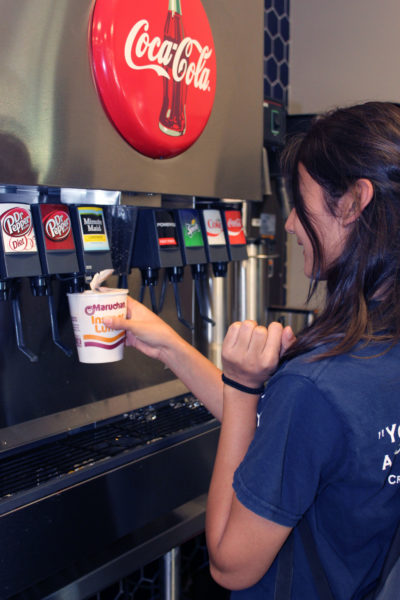Students crave more food options

Chartwells employee Yolanda Martinez Bernal works on daily outtake preparations. This fall outtake production has doubled. Photo by Christie Tavera
Responding to an increase of more than 1,000 additional students this academic year, Chartwells Schools Dining Services and Student Business Services are collaborating to increase food variety and availability for the campus’ growing population.
If approved by Texas A&M University-San Antonio, all members of the campus community will soon have access to a meal plan card, said Fred Wencel, district manager for Chartwells.
Chartwells is the primary supplier of food on campus, operating River City Cafe, 210 Burger Co., Houston St. and Salads out of the Main Campus cafeteria.
A&M-San Antonio’s Chief Financial Officer William Spindle confirmed the university recently negotiated a longer contract with Chartwells. Spindle also confirmed food production has gone up this year as a result of increased enrollment.
American Campus Communities, the management firm of Esperanza Hall, requires students to sign up for a mandatory meal plan generating a revenue percentage from students’ daily spending.
According to university policy, students living in on-campus residence halls are required to purchase a $1,250 resident meal plan. Students can add additional funds to accounts in increments of $50 through the Student Business Services office.
The meal plan functions like a debit card, students swipe their identification card at a dining location of their choice, and the cost is deducted from their meal budget.
Meals may be purchased for retail price at the Food Court, Jaguar Java Coffee Shop and from food trucks partners located on campus.
There are no set number of required meal purchases per day or week, according to university policy.
To determine how much food to order, produce and sell, Chartwells reviews ‘dining dollars’ spent by residents.
“That allows them to build up the product that they are going to be able to offer,” Spindle said.
Spindle explained Chartwells does not receive state funding, the company’s sales and revenue is generated by the students, faculty, and staff.
“Because Chartwells is self generating, we call them auxiliary,” Spindle said.
The meal plan has gained popularity across campus, Chartwells managers said.
“We’ve had a lot of people who are not residents ask if they could buy a meal plan,” Wencel said. “We’ll work with the university on doing that and creating a commuter meal plan that students, faculty, and staff can purchase.”

Student responses to the new food options are mixed. Some students say they want more: more variety and more of an opportunity to help make the food decisions on campus.
“You have a home-style meal, which most of the time isn’t very good,” said first-year student Julian Thompson. “It varies from not very good, to decent, to excellent sometimes, but the excellent is quite a rarity.”
“Chartwells is well aware that they are trying to keep the variety of the food changing out because over time even your favorite meal gets boring,” Spindle said.
“We are hoping that they will be able to create the kind of variety to keep those students interested because interested students come back.”
Many students rely on on-campus food options because of the university’s semi-rural location. A round-trip bus ride to the nearest H-E-B can take more than an hour. Given the limited selection at The Marketplace, students say the options can get monotonous during a 16-week semester.
“I believe they need more variety, because all they have are burgers and sandwiches,” said business management major Chad Prince.
While hamburgers and sandwiches are a popular feature, the food court also serves salads, fried chicken, and Mexican food.
When asked for potential solutions to their food troubles, students were quick to offer ideas, including allowing students more control over their food.
“Honestly, what I want for myself is a kitchen for the students, because I can make some good food and it’ll be healthy food,” Thompson said.
Other students recommended expanding hours to accommodate for students with difficult schedules.
“Some people don’t get out of class until 9:45p.m. but they close at 8, so people are just supposed to starve,” said first-year student Aliana Aridando.
Some industrious students have taken to implementing their own solutions, eating out of the microwaves available in the dormitory.
First-year student Jacque Alvarez-Riojas offered tips to produce quick protein meals in the dorm.

“It’s really dumb, but what I do is buy a six-pack of eggs for the week, and I scramble it in a little cup and I put it in the microwave and I eat a microwave egg,” Alvarez-Riojas said.
Alvarez-Riojas said she envies UTSA’s food court and wants to see other companies move in on Chartwells’ turf.
The single most requested fix by students interviewed over a span of three weeks was to increase the variety, adding more breakfast items, and options for students hoping for a healthy first year.
Both Chartwells and the university have several feedback methods for students.
Wencel said that starting in October, the vendor will begin a student satisfaction survey to ensure an understanding of students’ needs and plans to respond to feedback.
Students can leave an email on the the company website at www.chartwellsschools.com, or speak with Chartwells director Scott Anglesey or the Executive Chef Luis Ahumada, both available on campus.
Wencel added the new Science and Technology Building, currently under construction, will include a full coffee shop beginning in August 2018.